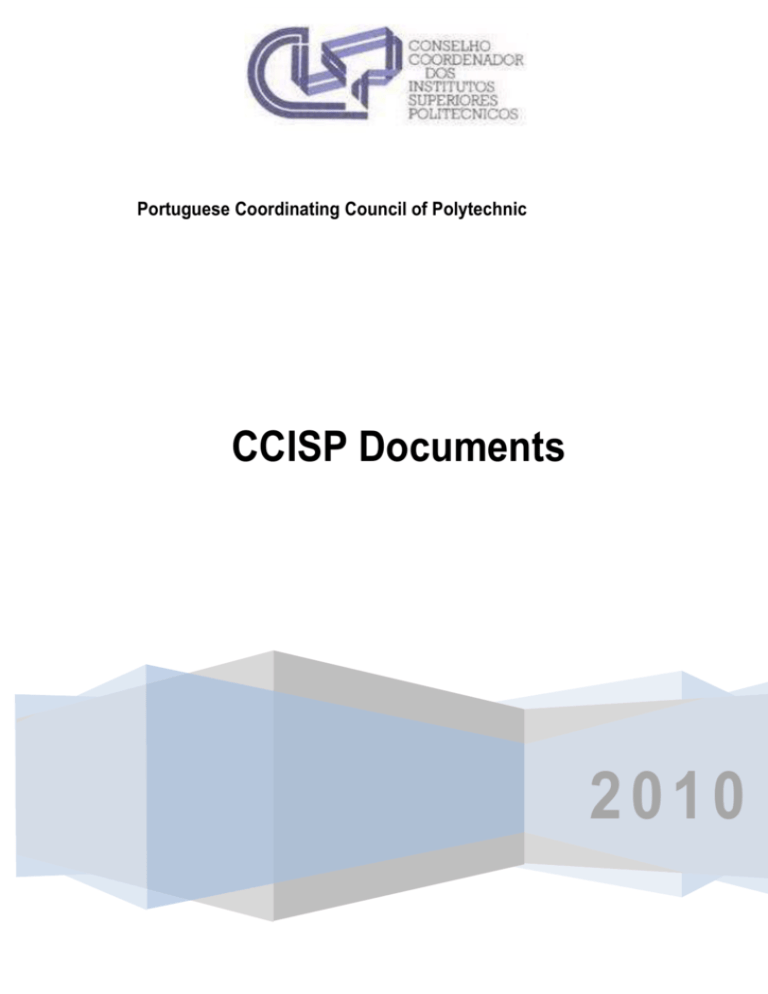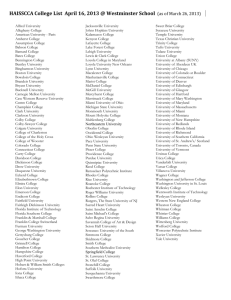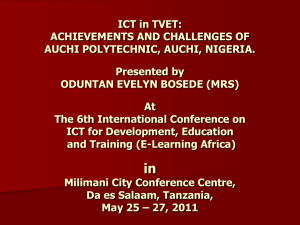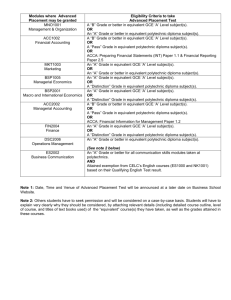1 Brief Description of the Portuguese Higher Education System
advertisement

Portuguese Coordinating Council of Polytechnic CCISP Documents 2010 Index Index ....................................................................................................................................................... b 1 Brief Description of the Portuguese Higher Education System ...................................................... 2 1.1 The Public University Subsystem and Its Institutions .............................................................. 2 1.2 The Public Polytechnic Subsystem and Its Institutions .......................................................... 3 1.3 Technological Specialisation Courses (CET) .......................................................................... 5 2 Access to Higher Education ........................................................................................................... 9 3 Statistics ........................................................................................................................................10 3.1 Number of Students ...............................................................................................................10 3.2 First Time Admissions in the First Year..................................................................................11 3.3 Public Higher Education Graduates .......................................................................................12 4 Contract Between The Ministry and the Polytechnic Sector ..........................................................13 5 Sector Collaboration ......................................................................................................................13 6 International Perspectives .............................................................................................................14 7 Annexes .......................................................................................................................................... ii I Distribution of Polytechnic Institutions in Portugal ........................................................................... ii II Higher Education Access ............................................................................................................... iii b III Evolution of the numbers of students enrolled in the public higher education system .................... iv IV Evolution of the number of students in Higher Education in Portugal (public and private) .............. v V Contract Between The Ministry and the Polytechnic Sector – CCISP Objectives .......................... vi c 1 Brief Description of the Portuguese Higher Education System The Portuguese higher education system comprises public and private education 1 and is organized according to a binary system which divides into the university and polytechnic subsystems. Study cycles in the university subsystem focus mainly on scientific knowledge, whilst polytechnic education stresses vocational skills and advanced technical training, making it, therefore, more professionally oriented. Despite this binary division of the Portuguese higher education system, it should be noted, however, that the Portuguese legal framework allows for the integration of polytechnic education schools in universities, albeit exceptionally. 1.1 The Public University Subsystem and Its Institutions 1 2 3 4 5 6 7 8 9 10 11 12 13 14 15 1 Universidade Aberta Universidade da Beira Interior Universidade da Madeira Universidade de Aveiro Universidade de Coimbra The public network of university institutions is made up of 15 universities that cover mostly coastal mainland Portugal and the Madeira and Azores archipelagos. Unlike polytechnic institutes, Universidade de Évora universities Universidade de Lisboa licenciatura and mestrado degrees. Furthermore, universities play a Universidade de Trás-os-Montes e Alto Douro Universidade do Algarve Universidade do Minho Universidade do Porto Universidade dos Açores Universidade Nova de Lisboa Universidade Técnica de Lisboa Instituto Superior de Ciências do Trabalho e da Empresa can award doutoramento degrees, alongside crucial role in the field of research. The nature of the training provided also sets the difference between university and polytechnic higher education. The university system favors more of a conceptual approach, less oriented towards professional activities, as opposed to the technical approach in polytechnic institutes. Table 1 – Universities For the purpose of this document, the public higher education system is addressed in greater detail. ~2~ As previously mentioned, Portuguese universities can award licenciado, mestre and doutor degrees. The licenciatura has between 180 and 240 credits. Finally, in the university subsystem, through the mestrado, the student should obtain an academic specialization based on research and innovation activities or the development of professional skills. Picture 1 – Geographical Distribution of University System in Portugal (Source: DGES) 1.2 The Public Polytechnic Subsystem and Its Institutions Public higher education polytechnic institutions, as above-mentioned, provide training oriented towards professional life. Thus, the legislator saw fit that these institutions concentrate their efforts in the creation, transmission and dissemination of culture and professional expertise, as well as in the development of applied research. Therefore, educational offer in the polytechnic higher education subsystem encompasses ~3~ Picture 2 – Geographical Distribution of the Polytechnic System in Portugal (Source: DGES) namely the following areas: technologies, tourism, health, education, agriculture, sports and arts. The network of polytechnic higher education institutions comprehends 15 polytechnic institutes 2, 5 nonintegrated schools and 7 universities, which, as explained before, can sometimes integrate polytechnic education schools. Institutions The geographic distribution of No. of licenciatura degrees offered No. of Schools Beja 25 4 Bragança 46 5 Castelo Branco 35 6 Cávado e Ave 15 2 Coimbra 45 6 Guarda 24 4 Leiria 57 5 Lisboa 41 8 densely Portalegre 27 4 Porto 74 7 populated areas. Since they are Santarém 29 5 Setúbal 33 5 spread across all regions of the Tomar 24 3 Viana do Castelo 26 5 country, polytechnic institutions Viseu 37 6 play an important role in the Esc. Sup. de Enfermagem de Coimbra 1 1 Esc. Sup. de Enfermagem de Lisboa 1 1 Esc. Sup. de Enfermagem do Porto 1 1 10 1 Escola Náutica Infante D. Henrique 5 1 Univ. Évora 2 1 Univ. Minho 1 1 Univ. Trás-os-Montes e Alto Douro 1 1 Univ. Madeira 1 1 Univ. Aveiro 21 3 Univ. Açores 2 2 Univ. Algarve 31 4 614 94 polytechnic institutions is more homogenous than that of university institutions, which, with only a few exceptions, are situated near the coastline in more development of the regions where they are established. In fact, they attempt to respond to the specific challenges of each region by training technical personnel, generating wealth and acting as a source of innovation. On the other Esc. Sup. Hotelaria e Turismo do Estoril Total hand, they are also an effective tool against Table 2 – Polytechnic Institutions in Portugal – 2008 (Source: migration from inland to coastal Portugal, Anuário Financeiro das Instituições Públicas de Ensino given that they capture students which Superior Politécnico - 2008) would otherwise move to larger cities where they would, eventually, come to reside. 2 A polytechnic institute integrates two or more schools of different domains. ~4~ With regard to academic degrees, polytechnic institutions can award the licenciado and mestre degrees and are not allowed to award the doutor degree. Study cycles which lead to the licenciado degree normally have 180 ECTS3. Study cycles which lead to a mestre degree usually have between 90 and 120 ECTS4. Finally, polytechnic mestrados should certify that the specialization obtained is of a professional nature. Moreover, polytechnic institutions provide other types of training, such as postgraduate studies and technological specialisation courses (CET), which are, for the most part, held in polytechnic institutions, given their technical, practical and vocational nature. 1.3 Technological Specialisation Courses (CET) The CET is a post-secondary non higher education course which grants a ISCED 4 professional qualification. This type of professional qualification is obtained through a combination of general or professional secondary studies and technical post-secondary studies5. The completion of a CET guarantees a DET diploma (technological specialization diploma). 3 In some cases, they may have 240 ECTS in order to abide by legal regulations of access to a professional activity. 4 They can have 60 ECTS and a normal duration of two curricular semesters, as a result of a stable and internationally consolidated practice in that specialty (Article 18 no. 2 of DL no. 74/2006, 24th of March). 5 In www.dges.mctes.pt (Direcção Geral do Ensino Superior - DGES website) ~5~ Table 3 – Number of CET courses offered in the public polytechnic network (Source: Anuário Financeiro das Instituições Públicas de Ensino Superior Politécnico - 2008) 6 2005 2006 2007 2008 2007/2008 Polytechnic Institutes BEJA 22 39 220 234 BRAGANÇA 23 43 320 320 CASTELO BRANCO 0 63 89 107 CÁVADO E AVE 0 0 70 36 23 16 172 224 COIMBRA GUARDA 0 48 90 116 246 580 1.131 1.406 LISBOA 0 0 0 0 PORTALEGRE 0 0 54 82 21 0 58 59 SANTARÉM 0 0 0 114 SETÚBAL 0 0 44 131 TOMAR 0 0 434 427 VIANA DO CASTELO 0 44 56 193 76 81 42 116 411 914 2.780 3.565 ESC. SUP. ENFERMAGEM COIMBRA 0 0 0 0 ESC. NAUTICA INFANTE D. HENRIQUE 0 0 0 18 LEIRIA PORTO VISEU TOTAL 28,2% Non-integrated Schools in Polytechnic Institutes 1.3.1 Maiores de 23 anos Maiores de 23 anos (applicants over 23 years of age) are covered by a special system of access to higher education. It is meant for all those who have not been able to finish their secondary education and, in the course of their professional experience, have acquired new skills and wish to further their qualifications. Applicants undergo an admission exam that assesses their capacity to attend higher The Escolas Superiores de Saúde de Lisboa and Porto and the Escola Superior de Hotelaria e Turismo do Estoril are not included in this table. 6 ~6~ education. If they pass, they then enroll in the institution where the exam was held 7. The exam is prepared by each institution. Chart 1 – Number of students aproved by exam for the Maiores de 23 public higher education system (Source: GPEARI/MCTES) 12 000 10 498 10 000 9 005 7 368 8 000 6 164 No. of Students 6 025 6 000 4 437 4 000 3 130 2 980 1 727 2 000 0 Universidades 2006-2007 1 727 2007-2008 3 130 2008-2009 2 980 Politécnicos 4 437 7 368 6 025 Total 6 164 10 498 9 005 Anos 1.3.2 Distribution of Students According to Training The number of students in public polytechnic institutions, according to training, can be found in the table below. However, the table does not include data from the Escola Superior de Hotelaria e Turismo 7 Their entry is subject to the number of vacancies available in the institution. For more information on higher education access, see item no. 2. ~7~ do Estoril, the Escola Superior de Enfermagem de Lisboa or the universities which offer polytechnic courses. Table 4 – Students for type of training (Source: Anuário Financeiro das Instituições Públicas de Ensino Superior Politécnico - 2008) Percentages per institution Licenciatura degree Mestrado degree BEJA 2.752 72 234 0 3.058 3,2% BRAGANÇA 5.760 501 320 52 6.633 6,8% CASTELO BRANCO 4.403 145 107 98 4.753 4,9% CÁVADO E AVE 2.194 73 36 0 2.303 2,4% COIMBRA 9.749 388 224 236 10.597 10,9% GUARDA 3.052 104 116 96 3.368 3,5% LEIRIA 8.783 595 1.406 93 10.877 11,2% LISBOA 11.394 2.157 0 0 13.115 13,6% 2.593 84 82 121 2.880 3,0% CET Other Total Polytechnics Institutes PORTALEGRE PORTO 13.477 1.221 59 83 14.840 15,3% SANTARÉM 4.084 174 114 189 4.561 4,7% SETÚBAL 5.732 416 131 115 6.394 6,6% TOMAR 3.046 152 427 103 3.612 3,8% VIANA DO CASTELO 2.997 86 193 17 3.293 3,4% VISEU 5.964 187 116 137 6.404 6,6% TOTAL 85.638 6.355 3.565 1.340 96.374 100,0% Total (percentage) 88,4% 6,6% 3,7% 1,4% 100,0% Non-integrated Schools in Polytechnic Institutes ESC. SUP. DE ENFERMAGEM DE COIMBRA ESCOLA NAUTICA INFANTE D. HENRIQUE ESC. SUP. DE ENFERMAGEM DO PORTO 1.375 0 0 380 1.755 412 73 18 0 503 1.112 0 0 219 1.331 ~8~ 2 Access to Higher Education8 Access to public higher education in Portugal usually happens through a National Application limited by numerus clausus. The application is carried out in two stages. The first is meant for students who are eligible to apply after the publication of the results of the first stage of national exams, while the second is meant for students who only become eligible after the publication of the results of the second stage of national exams9. In order to apply for the national application, candidates must successfully conclude a secondary course or an equivalent and undergo entrance tests to the intended course in the institution where they want to enroll10. Moreover, the candidates’ application mark should be as high or higher than the minimum mark set by the higher education institution11. After the application procedure, candidate ordering is then established for each institution/course pair in descending order, according to application marks. The National Application holds a number of vacancies available for candidates with special personal conditions. These are known as special contingents. The following candidates can apply: residents of the Azores and Madeira; Portuguese emigrants; disabled students; military personnel under contract; In order to apply, these candidates must satisfy the requirements, conditions and demands of the general contingent. The same rules extend to them, namely the need to undergo entrance tests. 8 Annex II contains the Portuguese higher education access structure 9 Applicants that could have applied in the first stage but did not do so can also apply to the second stage. The marks in these entrance tests should be as high or higher than those required by the institution where the applicant wants to enroll. 10 The candidate may have to satisfy certain prerequisites, such as physical, functional or vocational conditions, in order to apply for certain courses. 11 ~9~ It is also possible to access higher education outside the National Application through special applications, which are meant for students with specific qualifications. Places available are determined annually by each high education institution. The following candidates may apply through special application: maiores de 23 – candidates that are over 23 and will only be admitted after completing and passing an exam that assesses the candidates’ capacity. The exam must take place in the institution the candidate intends to apply to; people with a high education degree; people with a DET (technological specialization diploma). Finally, there is yet another exception to the National Application, the special access regime to higher education. It is meant for: candidates from the Portuguese diplomatic mission or their relatives; Portuguese scholarship students studying abroad or government officials on official mission abroad; Portuguese Armed Forces officers; PALOP scholarship students; accredited diplomatic mission in Portugal; professional athletes; East Timorese people. 3 Statistics 3.1 Number of Students Over the last 20 years, the increase in the number of students in public higher education has been significant. If in 1995/1996 the public university and polytechnic system had about 198,800 students, in 2008/2009, there were over 282,000 students12. However, this increase contrasts with the decrease in 12 For a more detailed analysis on public higher education, see annex III. ~ 10 ~ the number of students in private education institutions – 114,600 in 1995/1996 against 90,500 in 2008/200913. 3.2 First Time Admissions in the First Year In 2008/09, about 115,000 students enrolled for the first time in the first year of a study cycle in (public and private) higher education. Among these, almost 87,988 enrolled in public higher education (76% of total new enrollments) and 27,384 in private higher education (24%). Through a careful analysis of the numbers pertaining to public higher education in the chart below, one can conclude that the increase in the number of enrollments in Portuguese public higher education has been a constant. In 2008/09, polytechnic education reached a quota of 38% in new enrollments. 100.000 80.000 60.000 40.000 20.000 0 Politécnicos 200 200 200 200 200 200 200 200 200 0-01 1-02 2-03 3-04 4-05 5-06 6-07 7-08 8-09 26.70 26.68 26.66 23.56 22.48 21.13 25.37 31.46 33745 Universidades 39.22 39.22 41.97 41.23 40.88 42.55 44.78 52.81 54243 Total 65.92 65.92 67.64 64.80 63.36 63.69 70.15 84.27 87988 Chart 2 - Evolution of the number of students enrolled for the first time in the first year of a public institution of high education in the public subsystem of higher education (Source: GPEARI/MCTES) 14 13 Evolution of the number of students in Higher Education in Portugal (public and private) Annex IV Includes all courses in higher education institutions (lasting two or more semesters and having 60 ECTS or lasting 300 hours and subject to assessment). 14 ~ 11 ~ 3.3 Public Higher Education Graduates The number of graduates has also increased in the Portuguese public higher education system. In 1995/1996, 8789 students graduated from polytechnics, but, in 2007/2008, the number rose to 27,103, a more than 300% increase. University higher education also witnessed an increase in its number of graduates of about 235%. Another important conclusion that can be drawn from this chart is the increase in the graduates quota from the polytechnic subsystem in public higher education, which went from 36% in 1995/96 to 42% in 2007/2008. Chart 3 - Public higher education graduates ~ 12 ~ 4 Contract Between The Ministry and the Polytechnic Sector At the beginning of 2010 the Ministry for Science, Technology and Higher Education signed a contract with the Portuguese Council of Polytechnic Institutes regarding the sector’s development program for the four year period between 2010 and 2013. The Program’s main features are: Increasing the number of placements in CET programs (i.e., more than 10 000); Doubling the amount of placements in courses offered after working hours (i.e., night school); Creating the e-polytechnic with more than 1000 placements (i.e., distance learning for adults over 23 years of age and life long learning); Doubling the amount of placements at the post graduate and masters level; Increasing the number of placements for adults over 23 years of age; Support the requalification of graduate students through post graduate and masters programs; Increasing the level of academic staff with a PhD degree so that they comprise 50% of academic staff in the polytechnic sector; Promote academic success; Create Entrepreneurial Promotion Offices; Create Canters of Applied Research that will operate as a network with the objective to promote the link between the academic community and the business world and help regional development through applied research and experimental development projects that must involve researchers from higher education as well as businesses, and industry. Internationalisation. 5 Sector Collaboration For many years there has been a lot of talk about mergers and reorganization of the higher education network in Portugal. However, there are no immediate public plans to this effect. Sector collaboration is referred to in the Higher Education Legal Regime and points toward the idea of consortiums. The ~ 13 ~ government has stressed the importance of consortiums. There is an interest in regional consortiums in the polytechnic sector and some institutions have already formed consortiums to offer specific programs. 6 International Perspectives The contract between the Ministry and the sector makes reference to internationalisation. The polytechnic sector in Portugal would like internationalisation to develop along two lines. Firstly, the sector would like to create a program that affirms the transversality of Portuguese polytechnic education at the European level and link it to the European Network of Universities of Applied Sciences (UASNET). The objectives of this program are the inclusion and transfer of professional competences and the integration of applied sciences in the educational mission at the professional and technological level. The sector would like to start the program in 2011. Secondly, the sector would like to promote polytechnic education in order to further the development of a Portuguese language speaking countries space of Higher Education. The sector would like to strengthen the relations with higher education institutions that are located in Portuguese language countries and promote exchange initiatives and mobility programs involving student and academic staff (like ERASMUS). It would also like to bet on distance learning that involves publics and institutions in these countries. ~ 14 ~ 7 Annexes I Distribution of Polytechnic Institutions in Portugal Source: DGES ~ ii ~ II Higher Education Access Higher Education Access Public Higher Education Private Higher Education Special Application Special Regime National Application Institutional General Contingent Access to Medical courses by people with a licenciado degree Special Contingents Students from the Azores/ Madeira People with disabilities Military personnel under contract with the Armed Forces Portuguese Emigrants ~ iii ~ Access People over 23 years old (Maiores de 23 anos) People with a graduated higher education course or with a technological specialization courses certificate (DET) Source: DGES III Evolution of the numbers of students enrolled in the public higher education system Source: GPEARI/MCTES ~ iv ~ IV Evolution of the number of students in Higher Education in Portugal (public and private) INSCRITOS POR SUBSISTEMAS DE ENSINO (ENTIDADE INSTITUIDORA) - 1995-96 A 2008-09 450 000 The red line represents the total 400 000 number of students in the Portuguese 350 000 higher education system. The light 300 000 green line represents the total of 250 000 students in the public higher education 200 000 system. Finally, the dark green line 150 000 represents the number of students in 100 000 private higher education. 50 000 Source: GPEARI/MCTES Ensino Superior Público Ensino Superior Privado ~v~ Total 2008-09 2007-08 2006-07 2005-06 2004-05 2003-04 2002-03 2001-02 2000-01 1999-00 1998-99 1997-98 1996-97 1995-96 0 V Contract Between The Ministry and the Polytechnic Sector – CCISP Objectives Goals Objectives Indicator No. of placements available in CETs Starting Point 2715 2010 2013 3718 5577 37% 105% 3009 4369 34% 94% 265 1195 165% 1095% 3717 5147 1. Increase the number of CET students Growth rate of placements available in CETs 2. Increase the number of students in courses after working hours (night classes) No. of placements available in night classes Growth rate of the no. of placements available in night classes No. of places available in long distance learning 3. Increase the number of long distance Growth rate of the no. of placements in long distance students learning 4. Increase the number of students in 2247 No. of placements available ~ vi ~ 100 2350 mestrados profissionais Growth rate of the number of placements available 58% 119% 1310 1295 555 No. of professors with a PhD 736 882 1726 Total number of professors 3539 3562 3520 Growth rate of academic staff in PhD programs 37% 36% 16% Rate of academic staff with a PhD 21% 25% 49% Rate of academic success 65% 65% 80% No. of teachers in PhD programs 5. Increase the qualifications of academic staff Improve the synergies of students’ extracurricular training, offering more short-term courses; encourage mechanisms that use e-learning training 6. Promote academic success No. of campaigns 11 7. Support students and labor market insertion of students who have finished a degree 27 60 Create Entrepreneurial Promotion Offices; potentiate partnerships and cooperation with entities linked to entrepreneurship projects; cooperate with Startup Creation Offices ~ vii ~ Create Applied Research Offices; boost multidisciplinary research; involve scientific areas associated to curricular unit objectives; encourage technical and scientific events; increase revenues by providing services to private and public entities 8. Reinforce applied research Establish a program of applied sciences at a European level 9. Internationalize Portuguese polytechnic higher education 10. Create and accreditate Quality Assurance Offices Create Entrepreneurial Promotion Offices, long distance learning in Portuguese speaking countries; establish protocols to create 2nd cycle in-person and/or e-learning system courses Quality Assurance Offices Quality Assurance Offices accredited by an international agency ~ viii ~ 0 18 18 0 18






